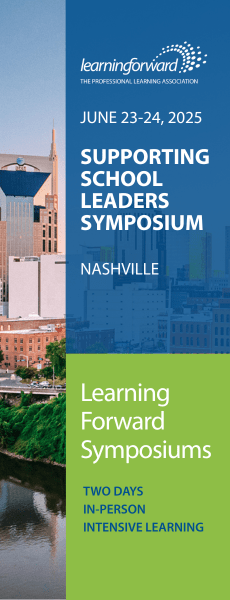The elements of effective teaching
Professional learning moves vision, framework, and performance standards into action
By Joellen Killion and Stephanie Hirsh
December 2011
Vol. 32 No. 6
Student success depends on effective teaching— not just occasionally, but every day in every classroom and school. Effective teaching impacts students’ academic, physical, socialemotional, and behavioral well-being. Effective teaching occurs best when all education stakeholders, including parents, policymakers, community members, and educators, share responsibility for continuous improvement and student achievement. For teachers in classrooms, effective professional learning is the single most powerful pathway to promote continuous improvement in teaching.
Consistently great teaching — every day, in every classroom, and in every school — emerges from a clear vision for teaching and learning. This vision is then translated into an instructional framework that details rigorous outcomes for student and educator performance. The framework and outcomes form the basis for the system for professional learning that makes them possible.
A vision for teaching and learning describes how students experience learning and the role of teaching in achieving that vision. Such a vision is grounded in learning theories and models selected to explain how learning happens, who the learners are, and the context in which students learn. The vision emerges from communitywide conversations among stakeholders who come together to describe the learning experience they want for students to prepare them for the future.
The following sample vision, based on the work of a national task force, describes teaching and learning based on the possibilities available through technology. Once a district establishes a vision, an instructional framework moves the vision from a dream to reality by describing how to achieve it.
“Imagine a high school student in the year 2015. She has grown up in a world where learning is as accessible through technologies at home as it is in the classroom, and digital content is as real to her as paper, lab equipment, or textbooks. At school, she and her classmates engage in creative problem-solving activities by manipulating simulations in a virtual laboratory or by downloading and analyzing visualizations of real-time data from remote sensors. Away from the classroom, she has seamless access to school materials and homework assignments using inexpensive mobile technologies. She continues to collaborate with her classmates in virtual environments that allow not only social interaction but also rich connections with a wealth of supplementary content. Her teacher can track her progress over the course of a lesson plan and compare her performance across a lifelong ‘digital portfolio,’ making note of areas that need additional attention through personalized assignments and alerting parents to specific concerns” (National Science Foundation Task Force on Cyberlearning. 2008. p. 5).
Whether an instructional framework is detailed or simple, it guides instructional decisions and builds accountability and consistency into learning experiences to improve results for students. See the sidebar below for examples of what such frameworks might include.
Visions for teaching and learning and instructional frameworks must be coupled with rigorous outcomes for student learning that specify what students are expected to know and be able to do as well as performance standards for educators. The Common Core State Standards in English language arts and mathematics become an essential component of effective teaching because they specify the expectations for student learning. Without clearly articulated outcomes, teaching may be fragmented or unfocused. These standards have been fully adopted in 44 states and the District of Columbia and partially adopted in one additional state; variations of these standards exist in other states or in individual school systems.
ASSESSMENT MATTERS
Generating a vision, developing an instructional framework, and delineating student learning outcomes by themselves are insufficient to produce effective teaching. Effective teaching requires not only explicit performance standards for educators but also processes for improving and assessing effective practice. Performance standards for teachers define instructional expectations and inform the individual improvement and criteria for measuring effectiveness. The Interstate Teacher Assessment and Support Consortium (InTASC), a collaborative of more than 30 states, provides model teacher standards for individual states and districts to use in developing their own performance standards (Council of Chief State School Officers, 2011). Others have contributed standards for effective teaching that are used as the basis for developing performance criteria such as those defined in Enhancing Professional Practice: A Framework for Teaching (Danielson, 2007) and Classroom Assessment Scoring System (Pianta, La Paro, & Hamre, 2008). For school leaders, the Interstate School Leaders Licensure Consortium provides model standards for school leaders (Council of Chief State School Officers, 2008). These standards contribute to a rich vision for leadership, teaching, and learning to establish a process of continuous improvement. See the diagram that demonstrates this relationship on p. 11.
Effective teaching emerges from a vision for teaching and learning, an instructional framework, standards for student learning, and performance expectations for educators coupled with a convergence of policy, planning, and goals at the state, school system, and school levels. Educators, policymakers, community members, and decision makers work collaboratively to develop and implement these components that serve as the backbone of effective teaching. Yet without professional learning to support implementation, these components are relegated to words on pages rather than actions in classrooms.
Effective teaching is possible in every classroom by ensuring every educator experiences substantive professional learning within a culture of collaboration and shared accountability. Effectiveness in teaching is a journey, rather than a destination. Each year, teachers experience new challenges to refine and expand their teaching practices. Each year, teachers face new students with different learning needs. They strive to implement new technologies in their classrooms to accelerate learning. Benchmarks for student learning continue to change. New research on effective instruction is released. New colleagues and leaders join the faculty to support teaching practice and student learning. Systems of professional learning are the only way to ensure these challenges become opportunities to improve student and educator performance.
Absent professional learning, teachers lack access to the information and support they need to refine and enrich teaching throughout their career. At each stage along the career continuum, effective teaching broadens from the core elements of teaching to include expanded responsibilities of a master or mentor teacher whose work includes supporting peers and assuming leadership roles within their schools and beyond that focus on improving student learning. Professional learning is the only strategy in school systems that moves the vision, instructional framework, standards for students, and standards for educators into action.
COMMON ATTRIBUTES
Effective professional learning for effective teaching has seven core attributes, which Learning Forward has defined as Standards for Professional Learning . Professional learning that doesn’t include these attributes is unlikely to produce the same high level of results for educators and their students that effective professional learning will. (See the full list of the Standards for Professional Learning below.)
A common attribute of effective schools is collaboration among educators. Engagement in one or more learning communities provides teachers opportunities to moderate their practice and expectations with their peers, to examine and reflect on their work together, to learn from one another, to challenge one another professionally, and to solve complex problems within the context of their unique work environment. Learning communities generate collective responsibility and accountability for effective teaching and student learning and engage teachers in school-based, ongoing learning focused on strengthening teachers’ day-to-day practice and reducing variation in the effectiveness of teaching from classroom to classroom within a school so that every student, regardless of his or her classroom, experiences the same high level of teaching each day.
Students benefit when teachers learn from peers. C. Ki-rabo Jackson & Elias Bruegmann (2009) report that when the quality of a teacher’s colleagues improve, the students of that teacher benefit. These results occur most likely because teachers organize the focus of learning within their communities on challenges relevant to their students’ success. Effective teaching and student learning are the benefits that spread from classroom to classroom and even from school to school.
Effective teaching requires skillful leadership to build capacity and structures to support learning. Leaders, both administrators and teachers, advocate professional learning as a key lever for continuous improvement of teaching and student results. While individual teachers may engage in professional learning aligned to their professional goals, universal effectiveness in teaching depends on making it a priority within a school or school system, creating a culture and systems to support it, and developing teacher leaders to skillfully facilitate collaborative learning.
In addition to leadership, successful schools and school systems invest resources to support effective teaching. Some of these resources include time for professional learning and collaboration, classroomand school-based support in the form of coaching, technology to seek information, models, networks, and research, and access to external experts who provide specialized knowledge and skill development when the needed expertise is unavailable within the school or district. The effects of these resource investments can be measured in increased student achievement.
Measures of increased effectiveness in teaching and student achievement depend on the use of formative and summative assessments that provide data about teaching performance and student achievement. These data plus data gleaned from examining student work and engagement, individual and collaborative teacher reflection, coaching, and other forms of peer interactions provide both informal and formal data the inform decisions related to improving teaching. These data also provide information to link results for students with changes in teaching practices. Without a regular stream of data about multiple variables related to effective teaching and student learning, teachers, their peers, and supervisors lack valid, reliable, and tangible evidence about effective teaching. These data provide a continuous stream of information against which teachers benchmark their progress and continuous improvement. Because of the significance of data in teaching and professional learning, effective teaching requires extensive assessment literacy and skill in using data to identify, plan, and measure the effects of ongoing professional learning.
Data allow teachers to identify the focus for their professional learning. The effectiveness of the learning experience is measured not only by the content, but also by the design of the learning experience. When professional learning for teachers models effective teaching practices, particularly those that are aligned with the vision of teaching and learning and the instructional framework, those engaged in the learning have an added advantage of learning both the content and processes about learning.
Effective designs integrate learning theories and research and foster active engagement and collaboration with colleagues. Learning designs vary to accommodate the expected outcomes, learners’ preferences, experience levels, school culture, and other factors. Teaching practices are enhanced through mentoring, coaching, and team learning that focus on clearly defined outcomes for teachers and their students.
Learning transfers to practice when mentors, coaches, and team members provide schooland classroom-based support sustained over time that draws on research about individual and organization change. Frequently, efforts to refine or extend teaching practices fail because the improved practices are not fully implemented with fidelity to the design. The use of constructive feedback based on predetermined criteria that describe effective teaching is also essential to continuous improvement of teaching.
CONTINUOUS LEARNING
Performance standards such as those described by Charlotte Danielson, Robert C. Pianta, Karen M. La Paro, and Bridget K. Hamre, InTASC’s model core teaching teaching standards, or state or district performance standards become an integral part of efforts to increase teaching effectiveness. Standards such as these align closely with the vision for teaching and learning and the instructional framework and define excellence in teaching. Coupling performance standards with student learning outcomes such as those defined in the Common Core State Standards creates a coherent set of criteria for both practice and results of effective teaching.
Effectiveness in teaching is a process of continuous learning that occurs over time without a termination point. As described in the InTASC standard 9, Professional Learning and Ethical Practice — “The teacher engages in ongoing professional learning and uses evidence to continually evaluate his or her practice, particularly the effects of his or her choices and actions on others (learners, families, other professionals, and the community), and adapts practice to meet the needs of each learner” (Council of Chief State School Officers, p. 18) — effective teaching includes reflection using data, engaging in professional learning, and adapting practice to meet the learning needs of students.
School systems have responsibilities to develop and embrace a vision for teaching and learning, adopt an instructional framework that guides how the vision moves into action, and establish standards that serve as the criteria for measuring effectiveness. Effective teaching results from comprehensive efforts of the entire community who come together to create the core components of a state and local system for teaching effectiveness. This system is fundamental to guarantee that every student, not just some, experiences effective teaching every day, and every educator, not just some, understands his or her role in increasing student achievement.
References
Council of Chief State School Officers. (2008, April). Educational leadership policy standards: ISLLC 2008 as adopted by the National Policy Board for Educational Administration. Washington, DC: Author.
Council of Chief State School Officers. (2011, April).
InTASC model core teaching standards: A resource for state dialogue. Washington, DC: Author.
Danielson, C. (2007). Enhancing professional practice: A framework for teaching. Alexandria, VA: ASCD.
Jackson, C.K. & Bruegmann, E. (2009). Teaching students and teaching each other: The importance of peer learning for teachers. American Economic Journal: Applied Economics, 1(4), 85-108.
National Science Foundation Task Force on Cyberlearning. (2008). Fostering learning in the networked world: The cyberlearning opportunity and challenge.
Washington, DC: National Science Foundation.
Pianta, R.C., La Paro, K.M., & Hamre, B.K. (2008).
Classroom assessment scoring system. Baltimore: Brookes Publishing.

Joellen Killion is a senior advisor to Learning Forward and a sought-after speaker and facilitator who is an expert in linking professional learning and student learning. She has extensive experience in planning, design, implementation, and evaluation of high-quality, standards-based professional learning at the school, system, and state/provincial levels. She is the author of many books including Assessing Impact, Coaching Matters, Taking the Lead, and The Feedback Process. Her latest evaluation articles for The Learning Professional are “7 reasons to evaluate professional learning” and “Is your professional learning working? 8 steps to find out.”

Stephanie Hirsh retired in June 2019 after 31 years with Learning Forward, an international association of more than 13,000 educators committed to increasing student achievement through effective professional learning. Hirsh led the organization as its executive director for the last 13 years where she presented, published, and consulted on Learning Forward’s behalf across North America.
Recent Issues
BUILDING BRIDGES
December 2024
Students benefit when educators bridge the continuum of professional...
CURRICULUM-BASED PROFESSIONAL LEARNING
October 2024
High-quality curriculum requires skilled educators to put it into...
LEARNING TO PIVOT
August 2024
Sometimes new information and situations call for major change. This issue...
GLOBAL PERSPECTIVES
June 2024
What does professional learning look like around the world? This issue...









